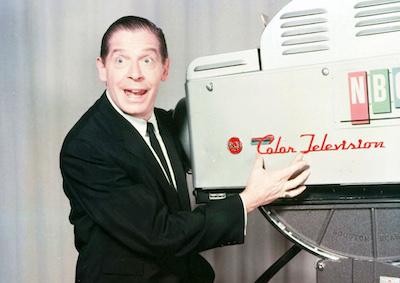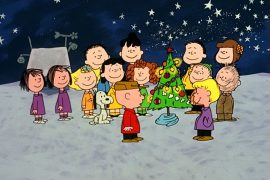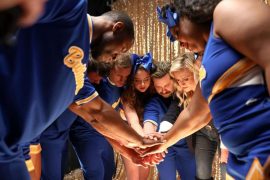Milton Berle was television’s earliest non-puppet breakout star. Let’s not forget Howdy Doody.
Berle’s Texaco Star Theater (1948-’53) a rambunctious comedy-variety series that stood out in the early days of network television, was the most-watched series among early set buyers. Berle himself joked that he sold more TV’s than anyone else. When his show came on, “my uncle sold his, my aunt sold hers…”
The comedian died at 93 in 2002. Berle’s manic energy, cross-dressing antics and Burlesque shtick eventually grew tiresome as more sophisticated shows gained favour, including I Love Lucy and Your Show of Shows. He even started to lose ground to timeslot rival Bishop Fulton J. Sheen who hosted the early televangelical series Life is Worth Living. Berle used to joke that they both worked for the same sponsor: “Sky Chief.”
Just this week, a restored colour broadcast — the oldest entertainment program known to survive on color videotape — was posted on-line for all to see at the UCLA Film & Television Archive site. It is an episode of the Kraft Music Hall Starring Milton Berle, originally broadcast live on October 8, 1958 — nearly 66 years ago. You can watch the half-hour episode above.
Milton Berle’s widow, third wife Lorne Berle (30 years his junior), located the original two-inch videotape and presented it to UCLA. Engineer David Crosthwait of DC Video in Burbank, CA, led the restoration efforts, and the result is an astonishing time capsule of what colour television looked like years before most homes even had a colour television set. It predates the previous oldest-surviving broadcast colour video, which featured Fred Astaire, by nine days.

Kudos, therefore, to the UCLA Television Archive for restoring and also for freely sharing this program. If you are into early television, there are several wonders here. First, there is about a minute in colour from the original tape from a prime time version of the previous program, The Price is Right, then hosted by daytime favourite Bill Cullen. NBC announcer Don Pardo (later famous for Saturday Night Live) can be heard at the end of that show promoting sponsors American Airlines, Allied Van Lines and others.
advertisement
There is a brief promo clip of the western premiering immediately after the Berle Kraft series, Bat Masterson. Star Gene Barry later makes an appearance towards the end of the Berle show.
The Kraft Music Hall was a well-established entertainment brand that had a long association on radio with Bing Crosby. It took a dozen years to bring the concept to television with Berle in 1958. There are live ads on the Berle episode, with Ed Herlihy announcing, featuring those ubiquitous hands fussing over party platters of everything from cheese and crackers to, yes, Kraft Dinner. There is even an ad for a box of Kraft’s Parkay margarine. Collect ten Parkay endflaps, says Herlihy, and you can redeem them for “flattering” pantihose — a dollar sixty-five value!
Berle opens with a monologue performed in front of a dozen or so studio audience members (some later revealed to be sponsors) seated directly before him. The set is not very impressive (it looks like an early SCTV parody of a Canadian variety show), but the “living” colour restortation is truly remarkable.
This 1958 outing was a comeback for Berle, who had worn out his welcome two years earlier after several incarnations of the Texaco show. NBC had signed him to a lucrative lifetime contract by 1953, but by ’58 it was looking more like when sports teams lock up an aging star past their prime. The Kraft gig lasted one season before Berle was down to hosting bowling for NBC. He bought hs way out of that contract to take his act elsewhere (including to Batman as a villian) in the ’60s.
On this colour Kraft series, Berle is wisely cranked way down from his early Texaco days, with many of the jokes self-depricating. He is announced by Ken Carpenter as having returned, “from the periphery of oblivion.”
He is seen at the start of the premiere banging on the locked doors of the Kraft Music Hall. Bob Hope opens the doors and hands him the key. Hope referenced The Millionaire, a popular TV drama of the day, then Berle makes a John Foster Dulles joke that lands but also has to be looked up now. A master milker, Uncle Miltie throws a look — a technique that extended a thousand jokes throughout his career.
Berle’s monologue starts with “I haven’t heard such applause since I announced I was quitting.” He says he’s now doing “adult comedy — which means if you don’t get laughs you just keep going.” One wonders what Berle would make of today’s often dramatic streaming comedies. He goofs on the many westerns on TV and says comedy will be back. Gleason lost 150 pounds, he quips, and the weight he lost has a show of its own now — “Fat Masterson.”
Berle’s monoloque is followed by a singer and a troupe of male dancers, all easily bypassed by innovations not available in 1958 — fast forwarding and skipping.
Berle ends his monologue with a bar or two of his signature tune “Near You.” Thanks to UCLA for bringing Berle and the early days of colour television near to all of us once again.






